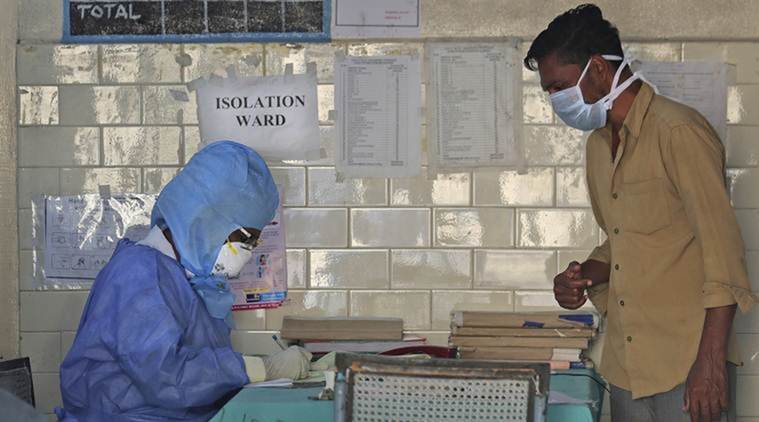 Currently, Indore’s sole testing lab for coronavirus, at MGM Government College, can handle a little more than 200 samples daily, while the average number of samples collected is nearly 400 per day. (File Photo/Representational)
Currently, Indore’s sole testing lab for coronavirus, at MGM Government College, can handle a little more than 200 samples daily, while the average number of samples collected is nearly 400 per day. (File Photo/Representational)
As the number of positive cases continues to rise in Indore, officials say they have put in place “the country’s strictest lockdown”, including geo-tagging of those quarantined, incineration of waste, and a massive sanitisation effort.
By Wedneday, the number of cases in Madhya Pradesh’s largest city stood at 544, a jump of 117 from the previous day. The 117 were among the 200 samples from Indore sent via a special flight to Delhi to speed up testing. District Chief Medical and Health Officer Dr Pravin Jadia said they had got results of 465 of the 1,142 samples sent. “Among those positive in Indore are 22 people whose report after treatment has now come negative.”
Jadia said the number of dead in Indore stands at 37, while 39 people have been discharged.
The samples had to be sent to Delhi as Indore has just one functional COVID-19 testing facility, which is struggling to manage the numbers as testing becomes more extensive. Now Bhopal is planning to send its samples to Delhi.
Having come under fire for lack of preparedness in the initial stages of the outbreak, leaving Indore with the highest mortality rate in the country, officials have now mapped the city into surveillance zones, started door-to-door screening by medical mobile units, and increased the number of isolation beds from 600 to 800.
Indore Nagar Nigam Commissioner Asheesh Singh said the city has been in complete shutdown since March 28, which means even essentials such as milk, food and groceries are being home-delivered by the administration. “Apart from medical shops, nothing is open. We have notified 13 very essential grocery items, including potatoes and onions.”
Singh said Indore’s well-organised sanitation system, helping it rank number one consistently in cleanliness rankings, has helped smoothen delivery glitches. “We have 470 waste-collection vehicles. We have a prescribed format with prices of items specified. People tick what they want. On every vehicle route initially we had only one grocery seller, now we have three.”
He said 22 large tankers with a capacity of 20,000 litres each, 11 special farm machines and two drones have been deployed to spray disinfectants. “In quarantine areas, special vehicles collect the waste. We treat it as biomedical waste and send it for incineration,” Singh said.
A senior police official in-charge of Indore’s lockdown said they were using technology to track those quarantined. “We are launching a mobile app soon where the moment a quarantined person steps out, police will find out.”
Jadia said on Tuesday alone, in the containment zones, 45,000 people were screened, of whom 300 were found with symptoms of cough and cold. “Doctors examined them thoroughly and have ruled for now that they were not COVID-19 symptoms.”
Officials said it was widened testing that had resulted in a backlog. As sample results come back from Delhi, they said, “we expect the numbers to rise for the next few days, and then stabilise”.
Currently, Indore’s sole testing lab for coronavirus, at MGM Government College, can handle a little more than 200 samples daily, while the average number of samples collected is nearly 400 per day.
Two private colleges and a private lab are waiting for permission from the ICMR to conduct tests, and Divisional Commissioner Akash Tripathi said one private college was likely to get permission by Thursday.
Tripathi also said it was not surprising that so many samples sent from Indore tested positive, pointing out that these were of people in close contact with positive cases. He also claimed that Indore was collecting more samples than other states (“800 per million”), explaining its high count.
Expressing confidence in the containment strategy, the Divisional Commissioner said the Muslim localities that were apprehensive about the testing in the beginning were also coming forward now. “Earlier they felt if they go in quarantine, something would happen to them. We reached out to the Shahar Qazi and other community leaders.”
Tripathi said what also made a difference was that in Tatpatti Bakhal, the area where a team of health workers was attacked, two patients returned after recovery. “They had good things to say about the doctors, which has created confidence among the community,” he said
Don’t miss these articles on Coronavirus from the Explained section:
‣ How coronavirus attacks, step by step
‣ Mask or no mask? Why the guidance has been shifting
‣ Besides a face cover, should I wear gloves when I go outdoors?
‣ How the Agra, Bhilwara and Pathanamthitta Covid-19 containment models differ